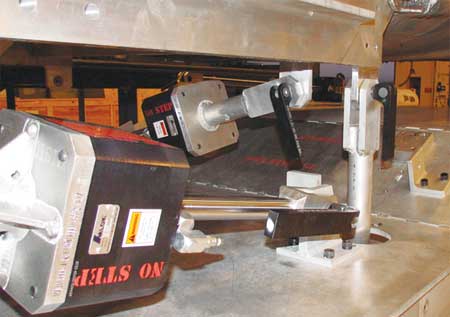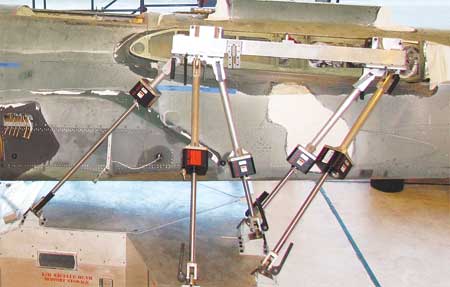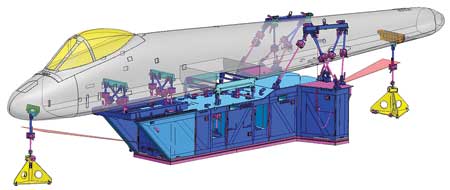
AMLOK rod locks shown at wing fitting attach points on the A-10 Warthog.

Rod locks shown on nacelle attach points.

Overall view of the structure built by Boeing St. Louis to hold the airframe of the A-10 Warthog during the refurbish/repair ops at Hill Air Force Base in Utah. Twenty-eight rod locks on each of the five total fixtures built by Boeing hold 5,000 lb. load and maintain a .002 - .003" maximum backlash, with no external load on the work surface, thus assuring the structural integrity of the fuselage during and after repairs.

Gun bay attach points.
During the maintenance and repair operations of the A-10 Warthog aircraft at Hill Air Force Base in Utah, a product design from Advanced Machine & Engineering (AME) helps maintain the structural integrity of this heavy airframe. AMLOK pneumatic rod locks keep the load steady and ensure the aircraft will return to flight in its proper configuration. Boeing in St. Louis designed and built the fixtures for the Air Force and specified the rod locks, 28 on each of five fixtures, constructed for use at the Air Force base.
In use, each rod lock holds up to 5,000 lbs. and maintains position with 0.002" - 0.003" maximum backlash and repeatable positioning. The AMLOK design functions by holding the cylinder rod in place and locking the load in place when air pressure is removed. Only when the pressure is restored can the load be released. This power-off clamping protects both the operators and the workload.
The Air Force contracted Boeing to produce a series of fixtures to help perform major structural repair operations on the A-10. This was a new product design, conceived by Boeing, to solve the problem of holding the massive A-10 airframe in position while major structural sections were removed and replaced. In application, the rod locks provide a means of attaching the main fixture to the aircraft structure without introducing any external load to the structure. This fact is key to the overall repair operation, as the original shape of the craft must remain consistent during and after the repair. In addition, since the locking feature on the rod lock is activated when the pneumatic power is removed, it prevents inadvertent activation of the lock during the repair process, increasing technician safety.
The AME rod lock design provides an easy-to-install interface between the main repair fixture and the surface of the fuselage on the aircraft, doing so in a way that prevents the introduction of positive or negative loads to the fuselage in the resting position. Prior to start-up of operations, laser tracking measurements of the A-10 Warthog fuselage were consistently monitored by Boeing personnel during the initial prototype repair processes.
In operation, rod locks are positioned at seven points on both sides of the fuselage along its entire length to provide adequate structural support. These points of contact also provide convenient attachment points on the aircraft, in relation to the components typically installed. In removing and replacing large sections of the fuselage, excess pressures can be exerted on the airframe, a potential cause of distortion.
Jack Bucheit, Lead Tool Engineer at the Boeing facility in St. Louis, said, "The size and weight of the aircraft necessitated a unique solution. Our requirements exceeded the capacity of the standard rod locks cataloged by AME in size and weight ranges. AME stepped up and developed, tested and supplied a specific rod lock designed to our specifications for this application. The performance was in line with all our expectations." Others on the Boeing team included Jerry Dunmire, A-10 Program Manager, Dan Dudley, Project Manager and Brad Moore, Tool Engineer.
The AMLOK rod locks on these fixtures minimize the over-travel, drifting, bouncing and reverse travel often encountered in pneumatic motion applications, according to the engineers consulted for this story.
Acting as the representative for AME on this project was Ray Varady, President of V-TEC Machine Tools, Inc. in Glen Carbon, IL, near St. Louis.
Shane Hatfield, Sales Manager at AME, led his team in the design and delivery of the rod locks to Boeing, who subcontracted the building of the fixtures to John Wisker and his team at WB Industries of O'Fallon, MO, also near St. Louis.
For more information contact:
Advanced Machine & Engineering Co.
2500 Latham St.
Rockford, IL 61103
815-316-5277
info@ame.com
www.ame.com